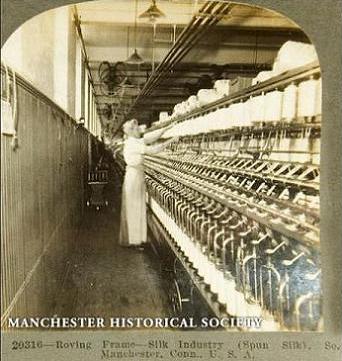



In this picture is shown a roving frame. The long row of bobbins is seen in action at the top of this frame. They contain "rovings," as the silk is now called after the fibres have gone through the numerous processes of cleaning, combing, straightening, and combining.
At the bottom of the frame are the spindles containing the thread. These spindles revolve at a high rate of speed, and as the roving passes down over the machine the fibres are twisted together into thread. As observed in the picture, the roving strips pass over a number of rolls or small cylinders and then come out in threads to be rolled up on the rapidly moving spindles. The long series of rovings which are drawn to the spindles, resemble very much a large number of small streams of some whitish liquid flowing through the small cup-like receptacles at the tops of the spindles.
The size of the threads is to some extent regulated by the speed at which the spindles revolve. The other chief factor in determining the size of the thread is the amount of fibre in the roving.
According to the census of 1910, there were in the United States 2,400,000 spindles. Since then it is estimated that about 350,000 more have been added.
For pictures and contemporary information on the Spinning Mill or 'Clock Tower Mill' in the
"Cheney Brothers National Historic Landmark District" page, click here.

 )
)